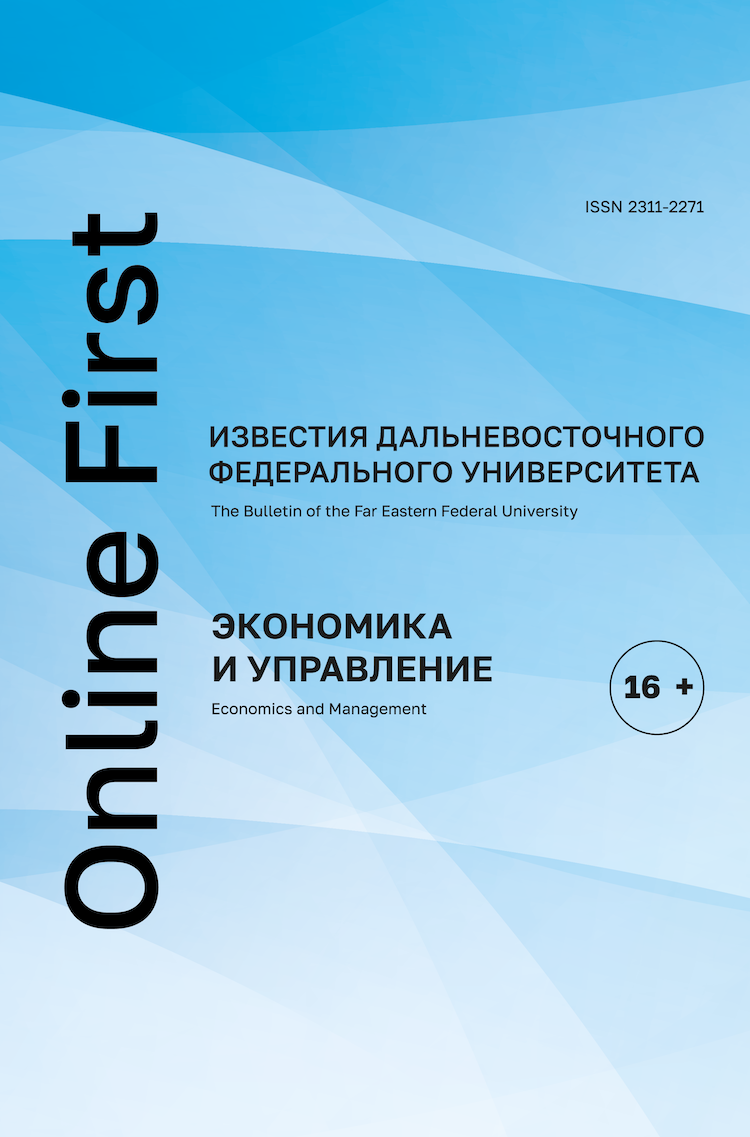Влияние интеллектуального капитала и распространения знаний на динамику производительности труда в условиях региональных ресурсных ограничений
Аннотация
Ключевые слова
Полный текст:
PDFЛитература
United Nations Development Programme. Human Development Report 2016. Available at: https://gtmarket.ru/files/research/human-development-index/Human_Development_Report_2016.pdf (accessed 10.09.2020).
Lind N.A. Development of the Human Development Index. Social Indicators Research, 2019, vol. 146, no. 3, pp. 409–423. DOI: 10.1007/s11205-019-02133-9.
Suri T., Boozer M.A., Ranis G., Stewart F. Paths to success: The relationship between human development and economic growth. World Development, 2011, vol. 39, no. 4, pp. 506–522. DOI: 10.1016/j.worlddev.2010.08.020.
Schiuma G., Lerro A., Carlucci D. The Knoware Tree and the Regional Intellectual Capi-tal Index: An assessment within Italy. Journal of Intellectual Capital, 2008, vol. 9, no. 2, pp.283–300. DOI: 10.1108/14691930810870346.
Lapygin Y.N., Makarov P.Y. Strategic Alternatives of Regional Intellectual Capital Man-agement. In: Popkova E. (eds) The Future of the Global Financial System: Downfall or Harmony. ISC 2018. Lecture Notes in Networks and Systems, vol 57. Springer, Cham, 2019. DOI: 10.1007/978-3-030-00102-5_55.
Liu C., Li X., Xu L. The Influence of Regional Intellectual Capital on Regional Economic Development: Evidence from Shandong Province. 2014 International Conference on Management of e-Commerce and e-Government, Shanghai, IEEE, 2014, pp. 280–284. DOI: 10.1109/icmecg.2014.64.
Pöyhönen A., Smedlund A. Assessing intellectual capital creation in regional clusters. Journal of Intellectual Capital, 2004, vol. 5, no. 3, pp. 351–365. DOI:10.1108/14691930410550345.
Ren J. Measure Research in Regional Intellectual Capital on the Basis of Multifactor Level Fuzzy Evaluation Method. 2008 Fifth International Conference on Fuzzy Systems and Knowledge Discovery, Vol. 3, Shanghai, IEEE, 2008, pp. 589–593. DOI: 10.1109/fskd.2008.591.
Loseva O., Fedotova M., Filimonova N. Methods for Measuring of Regional Intellectual Capital. Information, 2016, vol. 19, no. 6A, pp. 1771–1785.
Dezhong S. Regional Intellectual Capital Integration Performance Evaluation Based on Two-Phase Model. 2014 Sixth International Conference on Measuring Technology and Mechatronics Automation, Zhangjiajie, IEEE, 2014, pp. 467–471. DOI: 10.1109/ICMTMA.2014.115.
Blair H., Olpadwala P. Resource Constraints. In: Forestry in Development Planning, New York, Routledge, 2019, pp. 15–19. DOI: 10.4324/9780429044014-4.
Andreoni A. On manufacturing development under resources constraints. In M. Baranzi-ni, C. Rotondi, & R. Scazzieri (Eds.), Resources, Production and Structural Dynam-ics, Cambridge, Cambridge University Press, 2015, pp. 407–424. DOI: 10.1017/CBO9781139940948.023.
Getz W.M. Population dynamics: a per capita resource approach. Journal of Theoretical Biology, 1984, vol. 108, no. 4, pp. 623–643. DOI: 10.1016/s0022-5193(84)80082-x.
Taran O.L., Durdyeva D.A., Aslanov D.I., Bindasova N.A., Borlakova M.I. Assessment and Analysis of Resource Approach to Formation of Strategic Potential of Economy of the Region. International Review of Management and Marketing, 2016, vol. 6, no. S1, pp. 84–89.
Дроздова Ю.А. Ресурсный подход в исследовании территориальных общностей. Вестник Института социологии, 2019, том 10, №1, cc. 76–98. [Drozdova J.A. Resursnyi podkhod v issledovanii territorial'nykh obshchnostei [Resource approach in studying territorial communities]. Vestnik instituta sotziologii = Bulletin of the Institute of Sociology, 2019, vol. 10., no. 1, pp. 76–98.] DOI: 10.19181/vis.2019.28.1.557.
Макаров П.Ю. Базовая модель механизма воспроизводства интеллектуального ка-питала региона. Вестник Томского государственного университета. Экономика, 2018, №41, cc. 41–54. [Makarov P.Yu. Bazovaya model' mekhanizma vosproizvodstva intellektual'nogo kapitala regiona [The framework of the regional intellectual capital eco-nomic reproduction mechanism]. Vestnik Tomskogo gosudarstvennogo universiteta. Ekonomika = Tomsk State University Journal of Economics, 2018, no. 41, pp. 41–54.] DOI: 10.17223/19988648/41/3.
Pandey M.D., Nathwani J.S., Lind N.C. The derivation and calibration of the life-quality index (LQI) from economic principles. Structural Safety, 2006, vol. 28, no. 4, pp. 341–360. DOI: 10.1016/j.strusafe.2005.10.001.
Javaid A., Akbar A., Nawaz S. A Review on Human Development Index. Pakistan Jour-nal of Humanities and Social Sciences, 2018, vol. 6, no. 3, pp. 357–369.
Покровский С.В. Совершенствование механизма функционирования интеллектуального капитала. Автореф. дисс. канд. экон. наук. Москва, 2009. 22 с. [Pokrovskii S.V. Sovershenstvovanie mekhanizma funktsionirovaniya intellektual'nogo kapitala. Avtoref. diss. kand. ekon. nauk. [Improving the mechanism of functioning of intellectual capital. Author’s abstract Cand. Diss. (Econ.)]. Moscow, 2009, 22 p.]
Kastberg P. Knowledge Society. The International Encyclopedia of Strategic Communi-cation, New York, John Wiley & Sons Inc., 2018, pp. 1-5. DOI: 10.1002/9781119010722.iesc0097.
Japee G. Predicament of Knowledge Society: An Inquiry. International Journal of Inter-religious and Intercultural Studies, 2019, vol. 2, no. 2, pp. 60–67. DOI: 10.32795/ijiis.vol2.iss2.2019.455.
Novikov S. The Goal Of Education In Knowledge Society. The European Proceedings of Social & Behavioural Sciences EpSBS. EEIA 2019 - International Conference «Education Environment for the Information Age», Future Academy, Moscow, 2019, pp. 590–597. DOI: 10.15405/epsbs.2019.09.02.67.
Babaev B., Nikolaeva E., Babaev D., Borovkova N. Russia: Digital Economy or Industrial and Information Economy? In: Popkova E., Sergi B. (eds) Digital Economy: Complexity and Variety vs. Rationality, ISC 2019. Lecture Notes in Networks and Systems, vol 87, Springer, Cham, 2020, pp. 332–341. DOI: 10.1007/978-3-030-29586-8_39.
Rey R. Social Networks in the Information Economy. Social Sciences. 2019, vol. 8, no. 2, pp. 62–66.
Rogers М. The diffusion of knowledge and economic growth. Economics. Thesis PhD. Canberra, 1997. 293 p. DOI: 10.25911/5d66648c2902e.
Gallaud D., Torre A. Geographical proximity and the diffusion of knowledge. In: Fuchs G., Shapira P. (eds) Rethinking Regional Innovation and Change. Economics of Science, Technology and Innovation, vol 30. New York, Springer, 2005, pp. 127–146. DOI: 10.1007/0-387-23002-5_7.
Cowan R., Jonard N. Network structure and the diffusion of knowledge. Journal of Eco-nomic Dynamics and Control, 2004, vol. 28, no. 8, pp. 1557–1575. DOI: 10.1016/j.jedc.2003.04.002.
Guerrieri P., Maggi B., Padoan P.C. Economic growth and diffusion of knowledge: the role of distance. CIDEI Working paper No. 70, 2006.
Yadransky D., Chumak E. Time as a resource of the information economy. Baltic Journal of Economic Studies, 2017, vol. 3, no. 5, pp. 462–468.
Sherringham K., Unhelkar B. Crafting and Shaping Knowledge Worker Services in the Information Economy. Springer, Palgrave Macmillan, Springer Nature Singapore, 2020, 566 p. DOI: 10.1007/978-981-15-1224-7.
(c) 2020 Научный журнал "Известия Дальневосточного федерального университета. Экономика и управление"
© Дальневосточный федеральный университет, 1996-2022.
© Научный журнал "Известия Дальневосточного федерального университета Экономика и управление" - 16+.
Свидетельство о регистрации средства массовой информации ПИ № ФС77-57575
Издатель - ФГАОУ ВО "Дальневосточный федеральный университет".
При перепечатке ссылка на Сайт Журнала обязательна.
Коммерческое использование размещенных материалов запрещено.
E-mail: sem-journal@dvfu.ru





